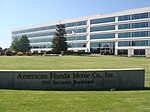Torrance Transit Center
2023 establishments in CaliforniaBuildings and structures in Torrance, CaliforniaBus stations in Los Angeles County, CaliforniaFuture Los Angeles Metro Rail stationsTransportation in Torrance, California ... and 1 more
Use mdy dates from January 2023
The Torrance Transit Center (officially the Mary K. Giordano Regional Transit Center) is a bus station in Torrance that serves as the city's transport hub. It opened on June 9, 2023. The station is planned to serve as the southern terminus of the Los Angeles Metro Rail C Line via a proposed extension.
Excerpt from the Wikipedia article Torrance Transit Center (License: CC BY-SA 3.0, Authors).Torrance Transit Center
Transit Center, Torrance
Geographical coordinates (GPS) Address Nearby Places Show on map
Geographical coordinates (GPS)
| Latitude | Longitude |
|---|---|
| N 33.8421 ° | E -118.3296 ° |
Address
Mary K. Giordano Regional Transit Center (Torrance Transit Center)
Transit Center
90501 Torrance
California, United States
Open on Google Maps







